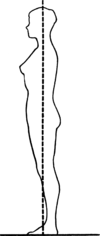4

The way in which you stand affects the health of your whole body. Good posture gives the body organs more room to do their work. If the chest is slumped, it is harder for the lungs to function properly. As you grow older, the muscle tone of the body decreases, and muscles do not give as much support: the shoulders tend to sag; the pelvis tips; and the stomach is thrust forward (Figure 1). This causes the base of the spine to move forward also, creating more pressure on the abdominal wall and abdominal organs. When the whole body mechanism is thrown out of line, backache and tiredness may result.
- 1. A tilted pelvis thrusts stomach forward and hips out. Good posture can add inches to your height.
Posture also has a relationship to feet. When the body slumps, the lower point of body balance shifts forward from its proper place at the ankle. This causes the feet to be thrown out of balance and may lead to foot trouble.
What is good posture?
Good posture is relaxed posture, but to relax does not mean to collapse. The three main divisions of the body-head, chest, and hips-should be balanced directly over one another (figure 2). They should be in a balanced position whether you are standing, walking, sitting, working, or sleeping. Good posture is a 24 hour-a-day job.

Good standing posture involves:
- Head erect and level
- Chin in and parallel with the ground
- Chest high
- Shoulders level, swinging free, and relaxed
- Abdomen flat, held up and in
- Lower back flat and tucked under
- Legs straight, with knees relaxed
- Feet parallel, with toes pointed straight ahead
- 2. If you are standing correctly, an imaginary line can be drawn from the top of the skull through ear, neck, shoulders, hips, knees, and instep.
